Most of what you read about growing an Instagram audience is either irrelevant or not enough
June 2018
Post consistently. Use hashtags. Join an Engagement Pod. Rinse. Repeat.
That’s basically the mantra, right? Every single blog post, YouTube video, or online course I read or watched on the Internet is either talking about all these things at once or going very vertical on one of them (to the effect of: "Definitive guide to Instagram Hashtags in 2018).
I decided to use data analysis to check their validity.
I followed these rules, so to say, quite methodically for about six months using my company’s Instagram account, @uniwhere, and my own Instagram account, @giansegato. Uniwhere is an app for university students, so community building for us is key.
The following analysis is based only on Uniwhere’s account.
I varied the activities along the way – like stopping doing something while introducing something else; in this way, I could have the necessary degree of variation needed for a comparative analysis.
I then connected a Python notebook to the Instagram Graph APIs and to our own database, and tried to draw some conclusions.
TL;DR version: post consistency, hashtags exposure and engagement pods do not correlate at all with followers growth. You can benefit from them, but not in terms of audience development.
Let’s see the details.
The Data
As a starter, I’d like to point out which kind of data I was able to analyse. Here it is my final dataframe:

As you can see, I have a normalised set of metrics that are either coming directly from Instagram, or coming from our own internal ETL system. Each row represents a day, starting from January 1st, 2018, and ending on June 10th, 2018.
I divided, for the sake of the analysis, the data into three buckets:
Actions
These are metrics that track explicit actions taken in order to grow the account:
did_post: whether in a particular day we posted a picture or not; it has a lagged version too, consistency: a trailing value that represents the degree of post consistency in the week before that day.vgm: whether, that day, the post was followed through by a push with an engagement pod. Engagement pods push the engagement of a specific picture skyrocketing (hundreds of likes), and more often than not they allow you to have your picture featured in the top post section of a hashtag. They work pretty simply: there are groups of people that like each other pictures at a certain, agreed time. So, a lot of engagement and potential exposure. This feature has a lagged variable too, vgm_effect: again, a trailing value of 5 days to take into account the possibility that engagement pods have a shifted effect in the days after the push.engagement: how much, on a particular day, we liked relevant pictures using hashtags of users we found on the platform. Another common, yet time-consuming, activity: you try to discover interesting pictures in a stream of pictures that are relevant to your nice, and you like them; the hope is that the receiver of the like visits your profile, likes it, and follows you.
Means to an end
These are the indirect results:
profile_views: how many users visited the account page in a given dayreach: how many unique users were exposed to our page in any mannerimpressions: how many times one of our pictures was seen in a given day
Little spoiler: impressions and reach are perfectly correlated (1.0), so we could potentially use the two terms as synonyms, even though they mean two different things.
Goals
And finally, the true, final, KPIs that we are interested in:
followers_count: how many new users we got on a given daywebsite_clicks: how many times the website link we are featuring on the account page was clicked
In the end, it all looks like this:
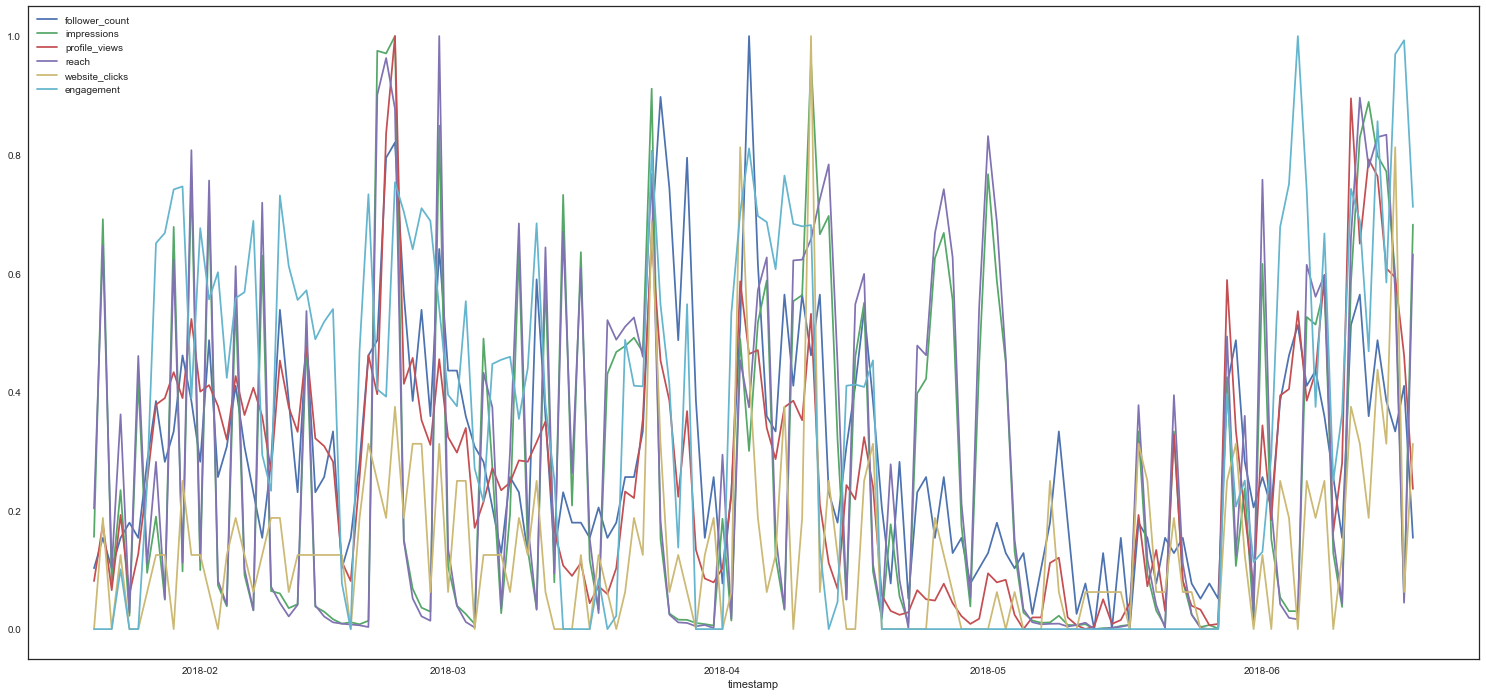
Ok, not so useful, I get it.
Divide et imperat: let’s consider small comparisons before piecing together the whole picture.
Post Consistency
In my humble opinion, I believe that the big, everlasting rule of "post consistently and get new followers" is very misleading. Is it useful to post consistently? Well, it doesn’t hurt. For sure it’s critical for your existing audience. But, looking at the hard evidence, it’s difficult to say that it helps growing it. Let’s take a look at this plot:
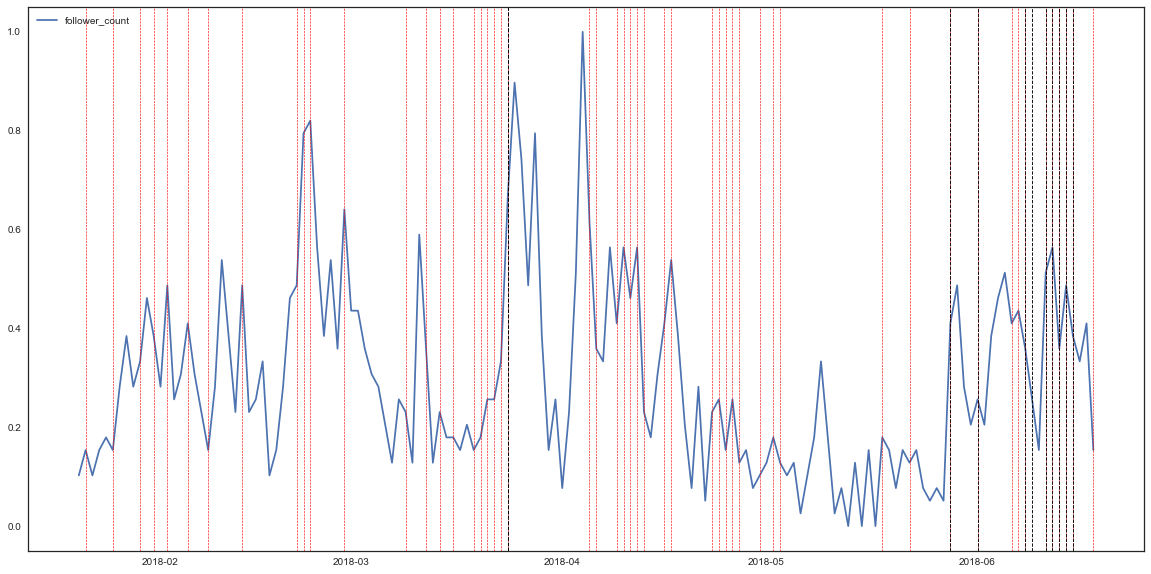
Red, vertical lines identify the days in which we posted a picture (did_post = 1). Black, vertical lines are the days when not only we posted a picture, we also pushed it using an engagement pod (vgm = 1).
Looks like there’s no pattern at all between the two things. However, it’s kind of difficult to infer some interesting take from this image, other than the quite clear "engagement pods doesn’t help" (which is still extremely interesting).
Let’s plot the same data, but this time using post consistency (that – I remind you – is a moving-window sum, and therefore can be plotted as a continuous line):
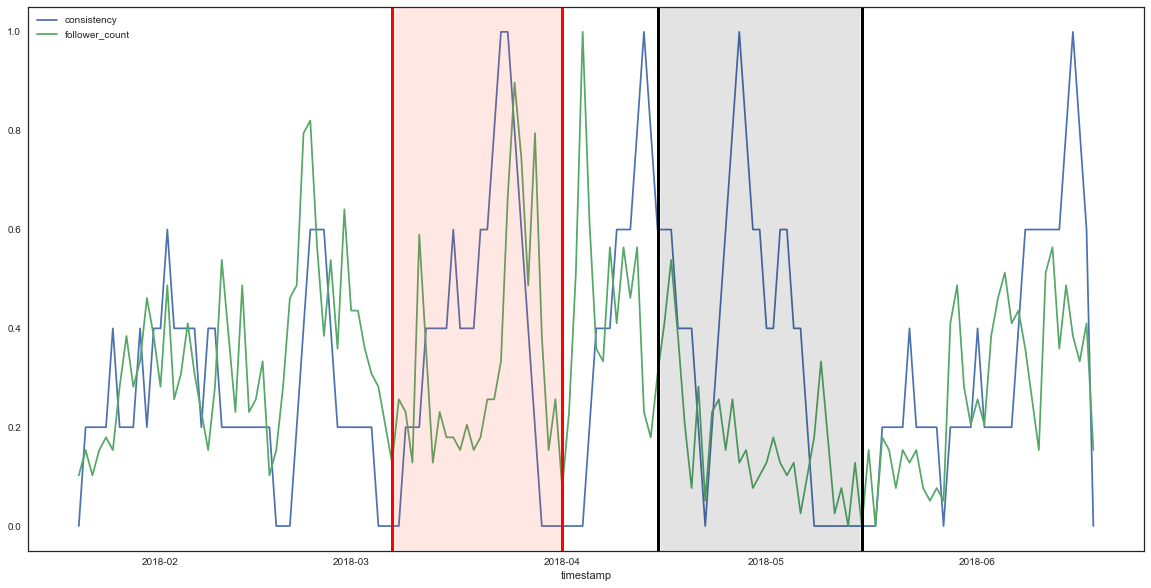
As you can see between March and April (the red area), there looks like to be an interesting correlation between followers growth and post consistency: the more I’m posting (blue line), the more my followers are growing (green line).
However, later on, between April and May (black area), new followers growth was stagnating, while the consistency was record high. So… it doesn’t really look like that posting more, or more consistently, directly affects the follower’s growth, nor does using engagement pods.
Action no. 2: Be Trending with Top Posts
There have been moments when our page has been trending in massive hashtags streams. We’ve got some of our pictures that made it to be top post of a 20MN-stream or so. However, it didn’t bring us much engagement, and, probably even worse, basically no new followers at all because of it.
Take a look at the following plot. It’s showing the relationship between impressions and followers count.
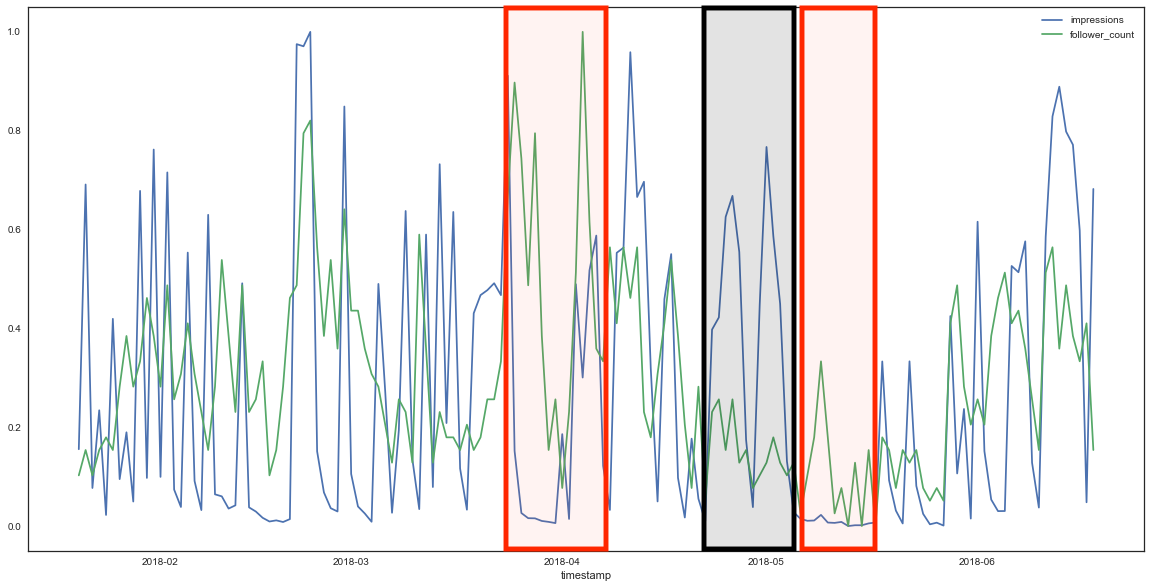
As you can see, in general, they kinda move in the same direction (I guess). However, you can totally have audience growth with no impressions (the two red areas), as well as good impressions with no growth (black area).
So… nope. Having your picture seen around a lot doesn’t correlate much with followers growth.
Action no. 3: Engage Around Like Crazy
I’m just gonna show you this one.
New followers to engagement (small reminder: engagement is defined as a parameter between 0 and 1 that quantifies the intensity of the likes sessions to other users in the platform – how much we interacted in a given day with other users):
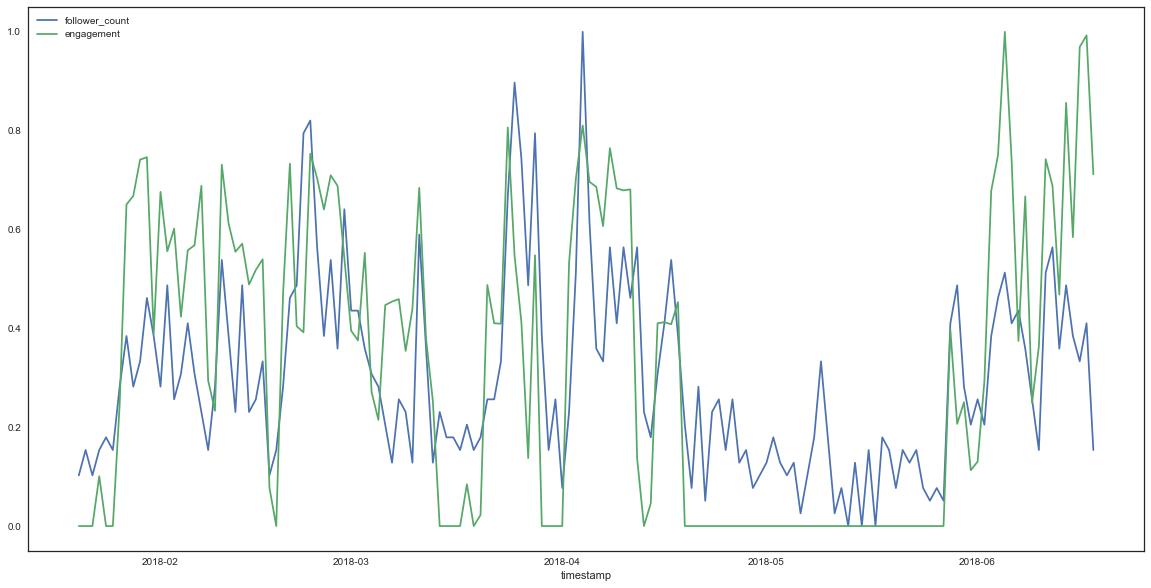
Website clicks to engagement:

Profile views to engagement:
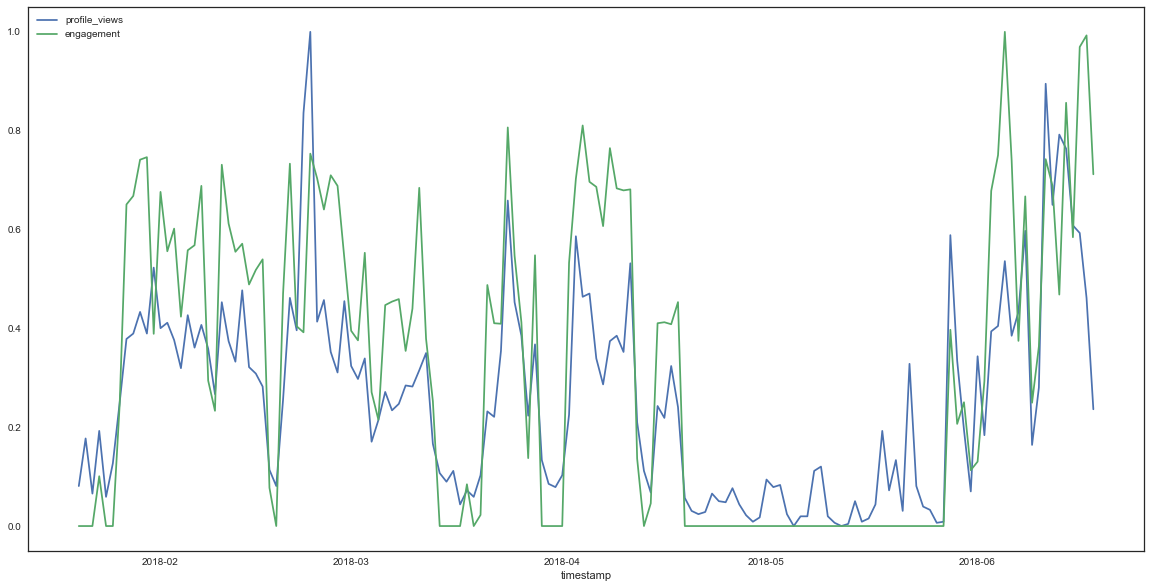
Boom. Engagement. It’s pretty much it.
When you like pictures around using the right hashtags, your profile views go up, and thus your followers count goes up as well, along with the website clicks.
That’s the only action that consistently proved to be a successful strategy to grow our Instagram audience.
Shall we cut the chase, please?
It’s time to have a look at the dataframe correlation matrix, which is basically a sum up of every possible plot I could potentially show you:

This picture extremely interesting. I’d need a few of these, from different accounts and different niches, in order to make a true generalisation, but as far as I can tell this is a pretty telling picture about how the Instagram game in 2018 works. In other words, every possible strategy you might come up with should be covered in here, at least from a correlation standpoint.
My most interesting takes from this little purple guy:
vgm_effectdoesn’t correlate with anything. Like, really, anything. It barely correlates with profile_views, which is obvious because those people in your engagement pod actually have to visit your profile in order to like your last picture.did_postheavily correlates with impressions and reach, which, again, is obvious: when you post, you make impressions, when you don’t, you don’t. But no sign of correlation with follower_count.follower_count, on the other hand, is heavily correlated with engagement and profile_views, and somewhat correlated with website_clicks. As we already seen in the plots before, investing time in liking pictures around is the only way to actually make new followers: you like pictures, therefore your profile gets viewed, people are exposed to your gallery and then they decide if it’s worth following you. In the process of deciding whether to follow you or not, they might visit your website.- To be fair, there’s some form of correlation between profileviews and impressions. However, I suspect that part of those profiles views that are coming after a spike of impressions (and therefore along with did_post) are your _own followers visiting your page because you posted something. So, no new followers, but engaged existing audience.
Takeaways (ie. what I learnt from this)
In the end, I think that the main takeaways to be drawn here are the following:
- Post only for your existing audience: do not expect your posts to generate more followers; not even if they "go viral"
- Use engagement pods only to boost your pics likes and have some social proof: do not expect engagement pods to be a magic wand to grow your audience
- Like, like, like and like. Rinse. Repeat.
Final note
Why not take into account the follow-for-follow strategy (I’m following people around expecting part of them to follow me back)? Well: I never did it, so I have no data about such strategy.
I believe it’s very successful in the short term, but I hate it, mainly because it conveys a very clear message of desperation, and you cannot scale it: either you keep every connection you make, and thus A. you hit the 7,500 limit fast, B. you truly look super desperate, or you unfollow every now and then some of your followers randomly, which is something that is quite dishonest, IMHO. So, nope, no data about it.
• • •